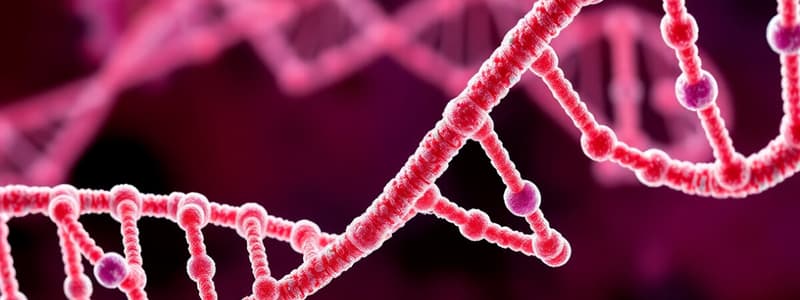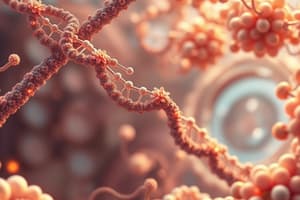Podcast
Questions and Answers
How does the direction of synthesis differ between the leading and lagging strands during DNA replication?
How does the direction of synthesis differ between the leading and lagging strands during DNA replication?
- Leading and lagging strands synthesize in a synchronous manner.
- Leading strand synthesizes towards the fork, while lagging strand synthesizes away from it. (correct)
- Both strands synthesize in the same direction towards the replication fork.
- Leading strand synthesizes away from the fork, while lagging strand synthesizes towards it.
What is the primary purpose of DNA ligase in the context of lagging strand synthesis?
What is the primary purpose of DNA ligase in the context of lagging strand synthesis?
- To unwind the DNA double helix for replication.
- To initiate replication at the replication fork.
- To add nucleotides continuously to the leading strand.
- To join Okazaki fragments into a continuous strand. (correct)
Why does the lagging strand undergo discontinuous synthesis?
Why does the lagging strand undergo discontinuous synthesis?
- It is a result of limitations in the replicative enzyme's function.
- It ensures that all nucleotides are added simultaneously.
- It accommodates the antiparallel nature of the DNA double helix. (correct)
- It allows for a faster synthesis process than the leading strand.
What characterizes the synthesis of nucleotides on the leading strand?
What characterizes the synthesis of nucleotides on the leading strand?
What are Okazaki fragments?
What are Okazaki fragments?
What is the main purpose of DNA replication in organisms?
What is the main purpose of DNA replication in organisms?
Which statement correctly describes a consequence of not replicating DNA before cell division?
Which statement correctly describes a consequence of not replicating DNA before cell division?
In the context of DNA replication, what role does the nucleus play?
In the context of DNA replication, what role does the nucleus play?
Why is DNA replication particularly important for cell growth?
Why is DNA replication particularly important for cell growth?
What is one reason cells undergo DNA replication during the process of repair?
What is one reason cells undergo DNA replication during the process of repair?
What aspect of DNA replication is crucial for reproduction in organisms?
What aspect of DNA replication is crucial for reproduction in organisms?
What is the first major step in the process of DNA replication?
What is the first major step in the process of DNA replication?
Which enzyme is responsible for adding nucleotides to the template strand during DNA replication?
Which enzyme is responsible for adding nucleotides to the template strand during DNA replication?
During which step is the template strand primed for replication?
During which step is the template strand primed for replication?
What role does helicase play in DNA replication?
What role does helicase play in DNA replication?
What is the correct sequence of events during DNA replication?
What is the correct sequence of events during DNA replication?
What is the end result of the assembly step in DNA replication?
What is the end result of the assembly step in DNA replication?
Which statement is true regarding the process of DNA replication?
Which statement is true regarding the process of DNA replication?
What is the main distinction between the conservative and semi-conservative models of DNA replication?
What is the main distinction between the conservative and semi-conservative models of DNA replication?
During DNA replication, how are new nucleotides connected to the old DNA strand?
During DNA replication, how are new nucleotides connected to the old DNA strand?
What does each new DNA molecule consist of in the semi-conservative model?
What does each new DNA molecule consist of in the semi-conservative model?
Which statement correctly describes the replication process based on the semi-conservative model?
Which statement correctly describes the replication process based on the semi-conservative model?
Why is the conservative model of DNA replication considered inaccurate?
Why is the conservative model of DNA replication considered inaccurate?
How does the diagram visually support the concept of semi-conservative replication?
How does the diagram visually support the concept of semi-conservative replication?
What do the light blue and red colors represent in the DNA replication diagram?
What do the light blue and red colors represent in the DNA replication diagram?
What role do the base pairing rules play in DNA replication?
What role do the base pairing rules play in DNA replication?
What is indicated about the parental double helix during the replication process described?
What is indicated about the parental double helix during the replication process described?
What is the primary role of DNA polymerase III in DNA synthesis?
What is the primary role of DNA polymerase III in DNA synthesis?
In which direction does DNA polymerase III synthesize the new DNA strand?
In which direction does DNA polymerase III synthesize the new DNA strand?
What is the role of RNA primase in DNA synthesis?
What is the role of RNA primase in DNA synthesis?
What is a consequence of DNA polymerase III's movement direction during synthesis?
What is a consequence of DNA polymerase III's movement direction during synthesis?
How does DNA polymerase III interact with the original DNA strand during synthesis?
How does DNA polymerase III interact with the original DNA strand during synthesis?
Which statement correctly describes the synthesis of the second DNA strand?
Which statement correctly describes the synthesis of the second DNA strand?
What is the template strand's significance in DNA synthesis?
What is the template strand's significance in DNA synthesis?
Why can't DNA polymerase III synthesize DNA in the 3' to 5' direction?
Why can't DNA polymerase III synthesize DNA in the 3' to 5' direction?
What is the significance of the primer laid by RNA primase in DNA synthesis?
What is the significance of the primer laid by RNA primase in DNA synthesis?
What occurs first in the DNA replication process during the synthesis of a new strand?
What occurs first in the DNA replication process during the synthesis of a new strand?
What is the role of the enzyme primase in lagging-strand synthesis?
What is the role of the enzyme primase in lagging-strand synthesis?
Which DNA polymerase is responsible for filling in the gaps left by removed RNA primers?
Which DNA polymerase is responsible for filling in the gaps left by removed RNA primers?
How does DNA ligase contribute to the process of lagging-strand synthesis?
How does DNA ligase contribute to the process of lagging-strand synthesis?
What is the significance of using RNA primers for Okazaki fragments?
What is the significance of using RNA primers for Okazaki fragments?
What occurs at the replication fork during the synthesis of the lagging strand?
What occurs at the replication fork during the synthesis of the lagging strand?
Why is lagging-strand synthesis characterized by the production of Okazaki fragments?
Why is lagging-strand synthesis characterized by the production of Okazaki fragments?
What is the importance of the directionality of the RNA primer in lagging-strand synthesis?
What is the importance of the directionality of the RNA primer in lagging-strand synthesis?
What triggers the formation of an Okazaki fragment on the lagging strand?
What triggers the formation of an Okazaki fragment on the lagging strand?
Flashcards
Leading Strand
Leading Strand
The DNA strand that is synthesized continuously during DNA replication.
Lagging Strand
Lagging Strand
The DNA strand that is synthesized discontinuously during DNA replication, created in short fragments called Okazaki Fragments.
DNA Replication Fork
DNA Replication Fork
A Y-shaped region where DNA replication takes place, where the DNA double helix is unwound.
Okazaki Fragments
Okazaki Fragments
Signup and view all the flashcards
DNA Ligase
DNA Ligase
Signup and view all the flashcards
DNA Replication
DNA Replication
Signup and view all the flashcards
DNA
DNA
Signup and view all the flashcards
Chromosomes
Chromosomes
Signup and view all the flashcards
Cell Division
Cell Division
Signup and view all the flashcards
Why is DNA replication essential for cell division?
Why is DNA replication essential for cell division?
Signup and view all the flashcards
What are the critical roles of DNA replication?
What are the critical roles of DNA replication?
Signup and view all the flashcards
Opening of the DNA Double Helix
Opening of the DNA Double Helix
Signup and view all the flashcards
Helicase
Helicase
Signup and view all the flashcards
Primer
Primer
Signup and view all the flashcards
DNA Polymerase
DNA Polymerase
Signup and view all the flashcards
Template Strand
Template Strand
Signup and view all the flashcards
New DNA Segment
New DNA Segment
Signup and view all the flashcards
Semi-Conservative Replication
Semi-Conservative Replication
Signup and view all the flashcards
Parental DNA
Parental DNA
Signup and view all the flashcards
Daughter Strands
Daughter Strands
Signup and view all the flashcards
Base Pairing
Base Pairing
Signup and view all the flashcards
DNA Unwinding
DNA Unwinding
Signup and view all the flashcards
DNA Synthesis
DNA Synthesis
Signup and view all the flashcards
Conservative Replication
Conservative Replication
Signup and view all the flashcards
Semi-conservative Replication
Semi-conservative Replication
Signup and view all the flashcards
What is the lagging strand?
What is the lagging strand?
Signup and view all the flashcards
What are Okazaki fragments?
What are Okazaki fragments?
Signup and view all the flashcards
What is primase?
What is primase?
Signup and view all the flashcards
What is DNA polymerase III?
What is DNA polymerase III?
Signup and view all the flashcards
What is DNA polymerase I?
What is DNA polymerase I?
Signup and view all the flashcards
What is DNA ligase?
What is DNA ligase?
Signup and view all the flashcards
What is lagging-strand synthesis?
What is lagging-strand synthesis?
Signup and view all the flashcards
What is the replication fork?
What is the replication fork?
Signup and view all the flashcards
What is the direction of DNA polymerase III movement?
What is the direction of DNA polymerase III movement?
Signup and view all the flashcards
What is an RNA primer?
What is an RNA primer?
Signup and view all the flashcards
How does the direction of DNA polymerase III affect the newly synthesized strand?
How does the direction of DNA polymerase III affect the newly synthesized strand?
Signup and view all the flashcards
What is RNA primase?
What is RNA primase?
Signup and view all the flashcards
How does DNA polymerase III know which base to add?
How does DNA polymerase III know which base to add?
Signup and view all the flashcards
What is the role of the original strand in DNA replication?
What is the role of the original strand in DNA replication?
Signup and view all the flashcards
Why is accuracy important for DNA polymerase III?
Why is accuracy important for DNA polymerase III?
Signup and view all the flashcards
What does DNA polymerase III do?
What does DNA polymerase III do?
Signup and view all the flashcards
What is the significance of DNA polymerase III?
What is the significance of DNA polymerase III?
Signup and view all the flashcards
Study Notes
Leading vs. Lagging Strands
- DNA replication fork: DNA unwinds
- Leading strand:
- Moves towards the replication fork
- Continuous DNA synthesis
- Nucleotides added one by one
- Lagging strand:
- Moves away from the replication fork
- Discontinuous DNA synthesis
- Adds nucleotides in "chunks", also called Okazaki fragments
- DNA ligase joins these fragments to form a single unified strand
- The two sides are replicated differently to accommodate the directional difference
Studying That Suits You
Use AI to generate personalized quizzes and flashcards to suit your learning preferences.



